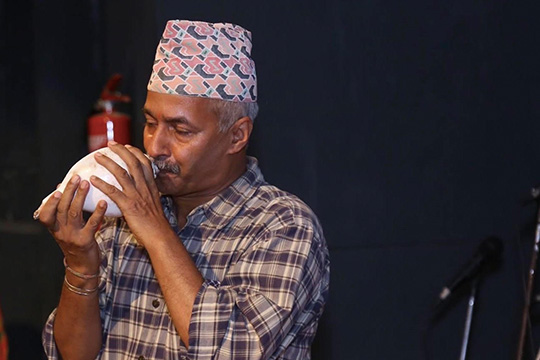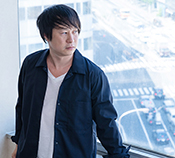Passing on folk instruments to the future.
(Part 1)
Ram Prasad Kadel / Founder of the Nepali Folk Musical Instrument Museum
Collecting musical instruments: a journey inspired by my holy Master.
Music in Nepal is rooted in the rhythms of day-to-day life perpetuated over generations. For Ram Prasad Kadel, music has been part of life since childhood. A merchant of Buddhist paintings known as thangkas, Kadel embarked on a project to collect the folk instruments of his country. The project was inspired by Kadel’s life-changing relationship with his holy Master.
My first memories of music were the songs of my grandmother.
Nepalese grandparents introduce their grandchildren to music by singing them songs. When I was three or four, my grandmother used to sit me on her lap and sing. Her songs probably formed who I am today in terms of music.
The Shankha is an often-played instrument in Nepal, made from the shell of a large sea snail—Triton’s trumpet. Almost every household has a shankha. The instrument is played twice a day, at dawn and at dusk, for prayer. I was playing the shankha by the time I was eight. Music was more of a daily routine than it was an entertainment or something we learned at school. Music was deeply embedded in the rhythm of our life at home.
In 1992, after university, I started a business with several friends who were skilled at making thangkas, a type of Buddhist painting scroll familiar to Hindus. Though I had some knowledge about thangkas, I wasn’t well-versed enough to run an actual thangkas business. A wide selection of books taught me more about thangkas, but book learning can only take one so far. I needed someone who could guide me deeply into the thangkas world and enlighten me on the religious significance of the paintings.

A simple idea, to do or make something for my country, blossomed into a museum of native musical instruments.
One day I decided to visit a learned man, a Guru widely known as “Swami Akhananda Saraswati.” Soon he was to become my teacher.
On first meeting, I said to him, “You must be the guru.”
“I’m not a guru,” he responded, “but I never turn down people who come to me to learn.”
I visited the Master every day to seek out his knowledge, knocking on his door at four o’clock every morning. After three months, he agreed to accept me as a disciple. In my visits to the Master, my Guru, I was to learn how to attain inner peace.
The most important condition for the attainment of inner peace is to lead a simple and strenuous life. Never allow yourself to become conceited. Live each day as a godsend, and the path forward will reveal itself.
After the completion of Dikshya (knowledge attainment), I asked my Guru what I should offer him as a Dakshina (gift to the Guru). He told me he wanted nothing, and asked that I do something for our nation instead. What that something might be, he didn’t say. It took me weeks of hard thinking to come up with an idea how I could contribute to Nepal, our nation. The idea that finally dawned on me was a museum of folk instruments.
More than 100 ethnic groups live in the various regions of Nepal. Many of the tribes have their own styles of music with distinct instruments. Their instruments are an irreplaceable cultural heritage of their ancestors. By archiving their music and musical instruments, the museum helps to protect and preserve the diversity of ethnic musical culture. Ultimately, the museum is maintaining Nepalese traditions.

The first step in collecting a musical instrument is to bond with its owners.
I told my Guru about my idea for a museum. He warned me of the insurmountable hurdles I would face.
“Are you up for the challenge?” he asked.
“My mind is made up,” I replied.
With the seed capital from the proceeds of my thangkas shop, I embarked on the project in 1995.
The first step was to gather information. I learned much by visiting owners of musical instruments and listening to them talk about their instruments. It was important for me to know about the histories of the instruments, about when and how they were made, about the kinds of people who typically played them, and so on.
It wasn’t an easy task to map out the whereabouts and types of musical instruments to be found throughout the country. Information doesn’t just serve itself up; I can only find it by asking around and researching as widely as possible. And once I locate an instrument, acquiring it is another challenge. Even if I locate one in a stroke of luck, I can’t simply turn up and ask for it. Who am I, to the owner of an instrument or a community where an instrument lives, but a mere stranger?
When I visit the owner of an instrument, I take a bus to the nearest town and walk to their place. A gentle arrival, on foot, is one way of showing respect. I choose to start by connecting with the people. They are my teachers, from whom I am trying to learn. This deferential attitude is fundamental to building a meaningful relationship. By facing them sincerely, I gradually win their approval. Without that approval, I would be in no position to discuss the donation of their instruments.

- Ram Prasad Kadel / Founder of the Nepali Folk Musical Instrument Museum
- Prasad Kadel, a Nepalese native, began a business of making and selling of Buddhist thangkas paintings in 1992. Three years later, he started collecting native musical instruments with a view to creating a museum showcasing the musical heritage of Nepal. The museum, opened in 2002, now houses more than 1,000 items representing 655 kinds of musical instruments. Kadel has also founded an annual folk music film festival to celebrate the musical cultures of Nepal and the rest of the world. Every day he plays the shankha, a horn fashioned from the shell of a large sea snail (Triton’s trumpet).
Interview Date:



